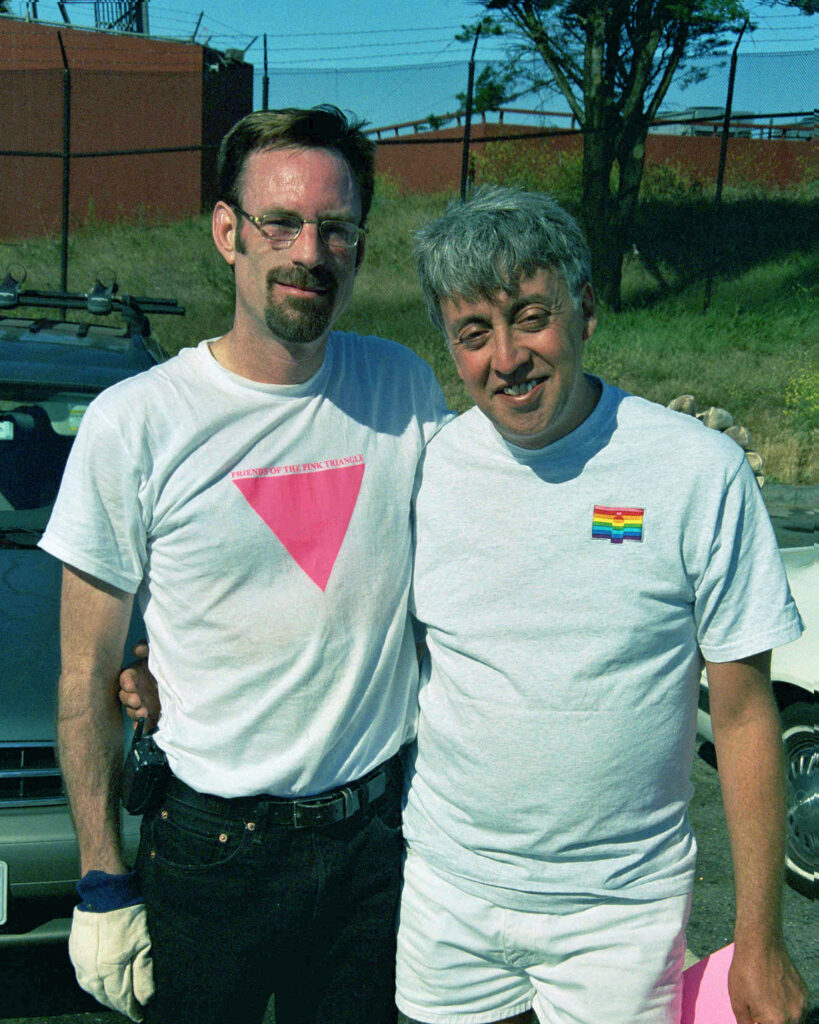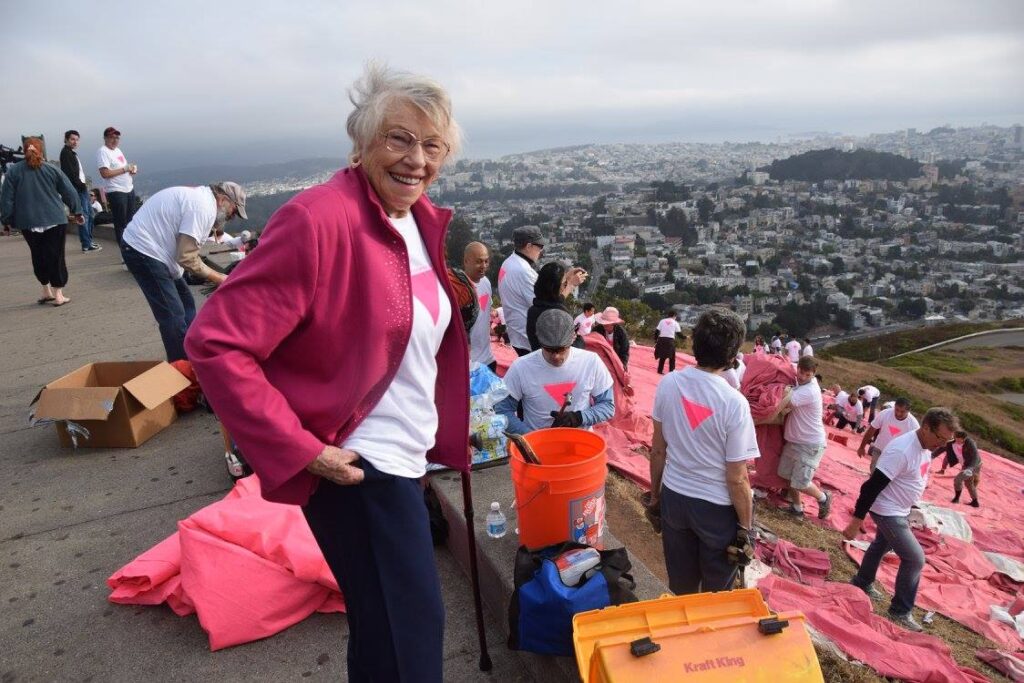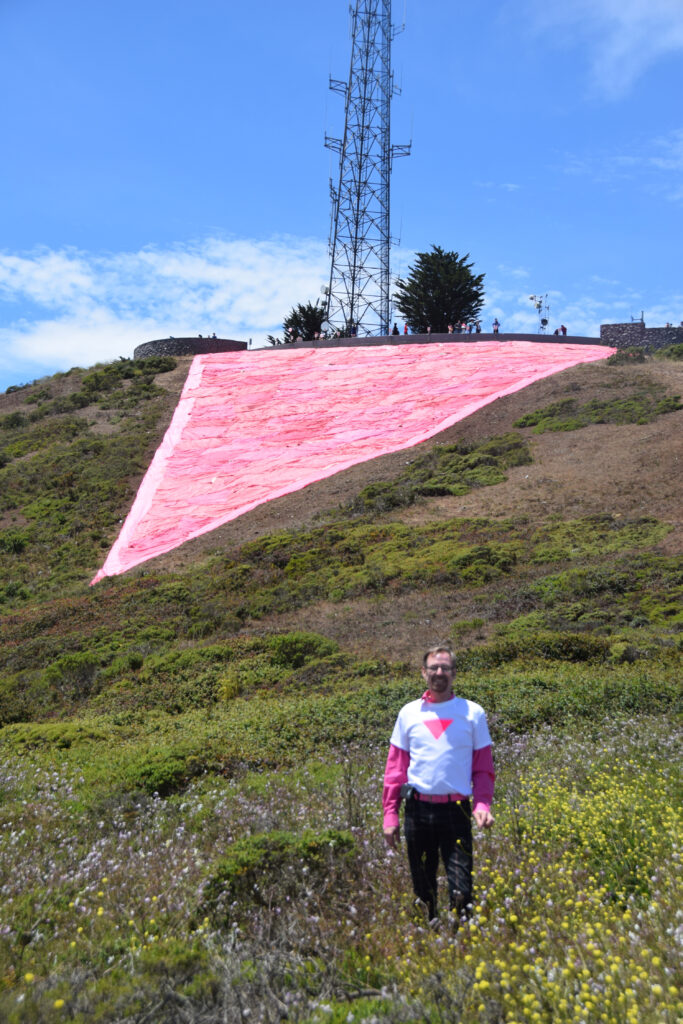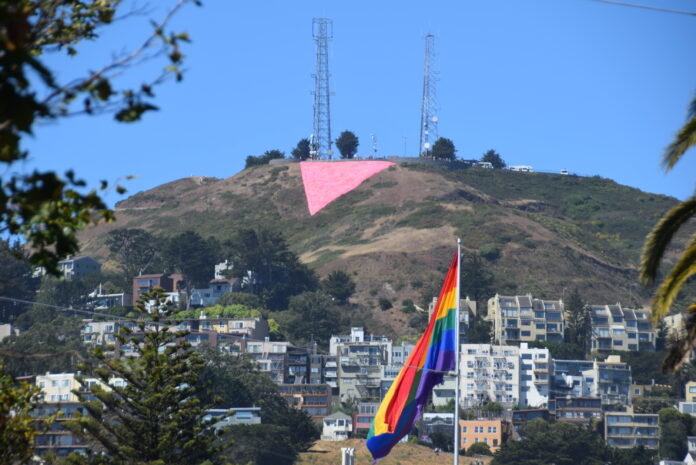Patrick Carney has an important PSA for everyone celebrating Pride in San Francisco this month: Stay vigilant.
It’s a message he’s been spreading for the past 28 years with a massive Pink Triangle display across Twin Peaks.
Recalling one the darkest chapters in history, the pink triangle—a Nazi-era symbol of gay othering, turned upside down and reclaimed by the LGBTQ+ community as an emblem of protest and pride during the Act Up era—is the perfect reminder of the consequence of complacency.
“Part of appreciating any Pride is knowing where you’ve been,” says the installation’s cofounder. “The pink triangle is exactly that—a reminder of what has happened and a warning that it could happen again.”
Connecting perfectly with Pride 2023’s theme of “Looking Back and Moving Forward,” the acre-size display, returns for its 28th year (Sat/17-July 1)—in its original canvas form (not the digital art installation seen over the past three pandemic years) with a more robust commemoration ceremony at 11am on Sat/17.

Mayor Breed, SF Pride Parade Grand Marshalls, and the SF Lesbian/Gay Freedom Band are set to attend, as speakers like SF Drag Laureate, D’Arcy Drollinger, activist Gary Virginia, drag legend Donna Sachet, and SF Pride Executive Director Suzanne Ford trace the trajectory of LGBTQ+ oppression from Nazi Germany to today.
Recent anti-trans and anti-drag bills in the US along with gay persecution in Uganda and Afghanistan are just a few of the obstacles the queer community continues to face.
“We’re definitely going backwards,” says Carney. “When we achieve victories, there’s always a surge of pushback against us. We are rising toward equality, but there’s this undercurrent of hatred that we must stop.”
I spoke to Carney about the continued importance of the pink triangle, why looking back is as vital as looking forward, and whether his perennial display could become a year-round installation.
48 HILLS If the LGBTQ+ community has come so far, why is it important to look backwards?
PATRICK CARNEY In the 2010s the persecution seemed to be dying down, for at least five or six years. It seemed like it was nothing but good news. Then Trump came in and all of these people crawled out of the woodwork that were embarrassed to speak out before. Trump gave them license to scream and burn and break windows.
The Nazis made it easy for Germans to feel comfortable looking the other way. It was scapegoating. They slowly scapegoated certain groups of people to be responsible for society’s ills. And we still seem to get that, rather than solving healthcare and gun-control issues.
It’s trans people are doing this and drag queens are causing that and gay men are doing this. It’s all about bringing up negativity toward certain groups. It’s an old playbook.

48 HILLS For most people, Pride is about celebrating and looking forward. How can a symbol like the pink triangle encourage them to understand the value of looking at where we’ve been?
PATRICK CARNEY I’ve received so many compliments about it from people that say they wanted to come and learn something deeper about our history—and they are moved.
I get emails from people in London, Ireland, and Germany, who say, “I stumbled across it. I saw in the newspaper that there was this event. So I went up there and helped install it and it was moving to see all the people working together to build it but especially poignant during the actual ceremony when I learned all of these things.”
Most people don’t know how intricate and far-reaching the hate was during the Holocaust. We know about the Jewish aspect of the Holocaust, as we should. And thank goodness that they are good at remembering the 6 million who died. But there are also these other groups, too, that have fallen through. And so many people didn’t know that the pink triangle came from the Holocaust.
People find it special to come up there. They think it’s a really important part of Pride to have that. The ceremony covers the whole gamut of the gay-rights movement. It starts out on a somber note with the history of the pink triangle and then ends with people talking about what else is happening Pride Weekend. We really do go from somber to festive in the course of a one-hour ceremony.
But it’s got to start out somber and it’s important to start off Pride week that way. It’s sort of a rite of passage. It’s like Muslims are required to visit Mecca once in their life. Well, gay people in the Castro should be required to help install the Pink Triangle.

48 HILLS Does starting off somber help us better appreciate the rights and freedoms we have today?
PATRICK CARNEY It does. Gay freedom or gay acceptance took a long, long time. So many people came before us that were killed, even after the Holocaust. So we’re walking on the shoulders of others and they were walking on the shoulders of others. And underneath them were many layers of other people walking on the shoulders of others. We’re rising up by stepping up on top of each other’s sacrifices. And this particular sacrifice is pretty well documented.
What happened in the Holocaust affected millions of people. The gay portion was a small fraction of that. But there were still a large number of gay people. So we need to remember we have to look back and remember what came before and where we could go again. So that’s my description right there. It’s a reminder and a warning. We have to be cautious because it could happen again.
48 HILLS Can you imagine the Pink Triangle becoming a permanent installation?
PATRICK CARNEY Yes, but it would require all sorts of permits. But maybe then it could become other things at different times of the year, like different colored triangles for other oppressed groups.
THE PINK TRIANGLE Sat/17-Sat/1, Twin Peaks, SF. More info here. Opening ceremony at 11am on Sat/17. The Pink Triangle relies on community support. Sign up to volunteer here and donate here.





